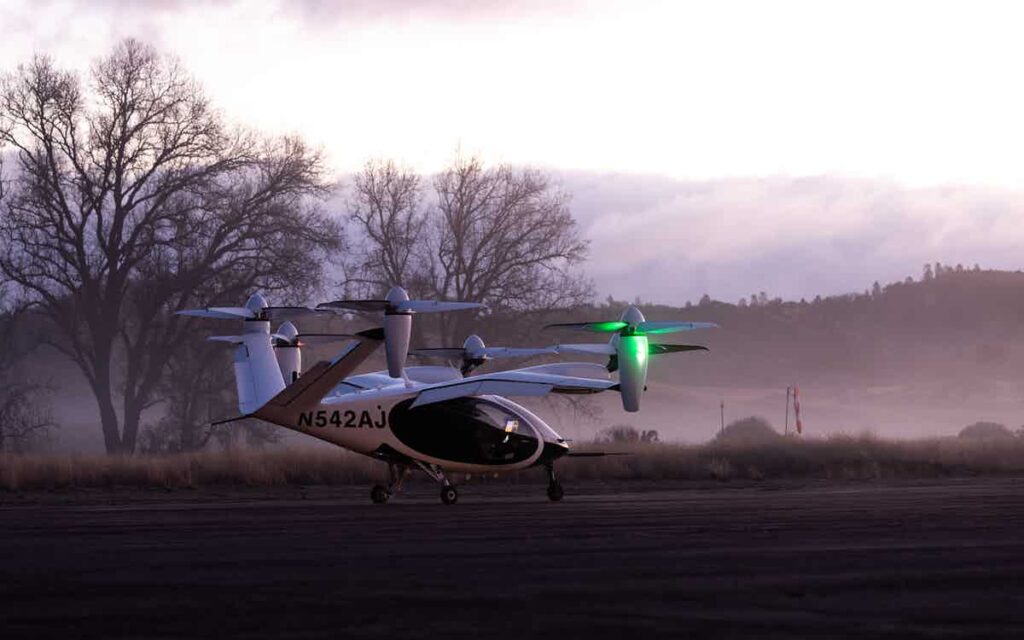
Joby becomes the first eVTOL company to test with NASA’s AAM National Campaign. (Joby)
NASA has begun the first electric vertical takeoff and landing (eVTOL) flight test of its Advanced Air Mobility (AAM) National Campaign with Joby Aviation, the agency announced on Sept. 1.
The AAM National Campaign is a multi-year effort to assist with the integration of AAM vehicles into the national airspace. NASA’s tests with Joby are occurring ahead of the first set of National Campaign tests, referred to as NC-1, that are planned for 2022. NC-1 will include more vehicle partners and flight scenarios.
“The National Campaign Developmental Testing is an important strategic step in NASA’s goals to accelerate the AAM industry timeline,” Davis Hackenberg, NASA AAM mission integration manager, said in a statement. “These testing scenarios will help inform gaps in current standards to benefit the industry’s progress of integrating AAM vehicles into the airspace.”
NASA’s testing with Joby will take place at Joby’s Electric Flight Base in California and run through Sept. 10, according to the agency. During the tests, NASA will be collecting vehicle performance and acoustic data from Joby’s aircraft which could be used to identify gaps in current regulations.
“NASA’s AAM National Campaign is critical to driving scientific understanding and public acceptance of eVTOL aircraft,” JoeBen Bevirt, founder and CEO of Joby Aviation, said in a statement. “We’re incredibly proud to have worked closely with NASA on electric flight over the past 10 years and to be the first eVTOL company to fly as part of the campaign.”
NASA will test the acoustics of Joby’s eVTOL using its Mobile Acoustics Facility and more than 50 microphones to measure the aircraft’s acoustic profile during flight, according to the agency.
“From day one, we prioritized building an aircraft that not only has an extremely low noise profile, but blends seamlessly into the natural environment,” Bevirt said. “We have always believed that a minimal acoustic footprint is key to making aviation a convenient part of everyday movement without compromising quality of life, and we’re excited to fly with NASA, our long-time partners in electric flight, to demonstrate the acoustic profile of our aircraft.”

Joby released a video in August comparing its noise profile to traditional aircraft and helicopters. (screenshot from Joby’s Youtube video)
In August, Joby released a YouTube video comparing its aircraft’s overhead noise profile to that of two fixed-wing aircraft and three helicopters. While the company was unable to release data related to the noise profile differences, the sound waves displayed in the video appear to show Joby’s eVTOL creating significantly less noise than the other aircraft.
NASA will also be collecting data on how Joby’s eVTOL aircraft flies and communicates with controllers, according to the agency.
To prepare for these tests, NASA used a Bell OH-58C Kiowa helicopter to create a blueprint for the eVTOL flight plan.
“We need a vehicle that has a vertical lift capability to test our flight test plan and that flight test plan is basically the blueprint of moving forward with our vehicle partners,” Starr Ginn, NASA AAM NC lead, told Aviation Today in March. “It’s to tease out what are going to be even some certification hurdles for the vehicles because the whole airspace architecture and infrastructure is built around the performance of the vehicle and so you got to come up with some minimum safety standard.”
Joby has already agreed to G1 certifications with the FAA and the company hopes to receive type certification by 2023 to facilitate a commercial launch in 2024. The company is also seeking a Part 135 Air Carrier Certificate to operate in cities and communities in the U.S.